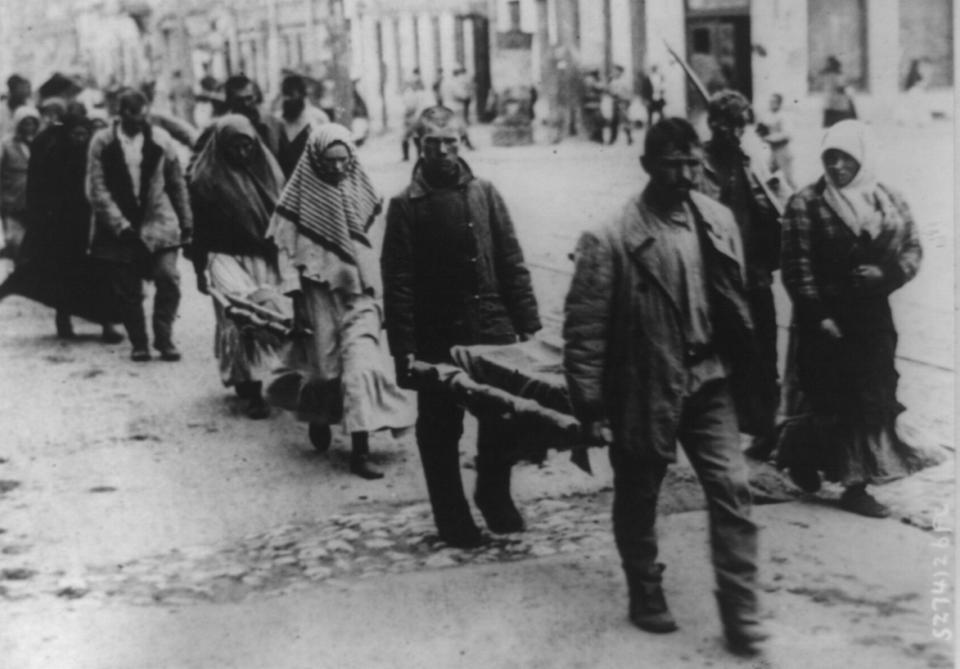How starving Russians became CANNIBALS and sold human body parts as meat in World Cup city where England clash with Sweden
Disturbing images capture the horrors of the Russian famine in the 1920s, which affected around 25million people

ENGLAND will clash with Sweden tomorrow in the World Cup city where starving Russians became cannibals and sold severed heads in a desperate bid to feed their families.
Disturbing images capture the horrors of the Russian famine in the 1920s, which affected around 25million people in the Volga and Ural River region of the vast country.
Samara – the city where England will play in the quarter finals – was one of the hardest-hit areas, its plight exacerbated by the civil war and Lenin’s decree to seize food from peasant farms to feed his Red Army Troops advancing “war communism”.
People were forced to eat grass, dirt, dogs, cats and leather horse harnesses.
There were reports of parents killing and eating their own children as rampant starvation made people take unimaginable measures to survive.
The average May rainfall for Samara was 38.8mm, but only 0.3mm fell in 1921. This was followed by deep frosts and millions faced starvation.
Despite reports of cannibalism, the police took no action as it was deemed a legitimate method of survival.
One picture shows a couple selling human remains, including the corpse of a young boy, in a degrading bid to feed themselves.
As news of the famine spread around the world, Britons and Swedes took part in a massive operation to save the children.
The mission was led by Swedish-born Arctic explorer Dr Fridtjof Nansen, whose telegram from Moscow told of the abject horror.
He wrote: “Twenty to thirty million are in famine conditions, of whom at least ten million are threatened with death. Whole populations in Central Russia are threatened with extermination.
"Vast districts becoming empty deserts. Urgent need immediate help. Cannot be exaggerated.”
Food from the Swedish Red Cross was already reaching the zones of devastation, but on his return Nansen appealed for help from British workers.
English journalist Sir Philip Gibbs visited the area and reported: “In Samara and hundreds of other places children are left by parents who cannot feed them.
"In the Samara district there are 28,000 abandoned children, as starved as birds who fall from the nest to the frozen ground.”
First World War leader David Lloyd George spoke of “the most terrible devastation that has afflicted the world for centuries”
He said: “This is so appalling that it ought to sweep away every prejudice out of one’s mind and only appeal to one emotion: pity and human sympathy.”
The “prejudice” he was referring to was anti-Soviet sentiment. Samara was caught-up in the war between Lenin’s Bolshevik revolutionaries – “The Reds” – and “the Whites” led by Admiral Kolchak.
The city was seized by the Bolsheviks in the 1917 October Revolution.
It was later taken back by a “democratic counter-revolution” before finally falling to the Red Army in 1918.
Fighting was worsened by Lenin’s policy of taking grain and animals to sustain the war effort.
Today, estimates suggest more than five million lives were claimed during the famine.
No.1 DESTINATION For our World Cup exclusives, gossip, action, video and fun
latest in world cup
Sweden’s role in the international relief effort was finally recognised in 2016 with a memorial by the river Volga.
Britain’s contribution – led by Save the Children - is less well-documented and largely forgotten .
Samara, today a city of 1.2 million people, sits on the river Volga more than 600 miles east of Moscow and almost 800 miles north of Volgograd – wartime Stalingrad – where England smashed Panama 6-1 earlier in the World Cup tournament.
We pay for your stories! Do you have a story for The Sun Online news team? Email us at [email protected] or call 0207 782 4368 . You can WhatsApp us on 07810 791 502. We pay for videos too. Click here to upload yours.


























